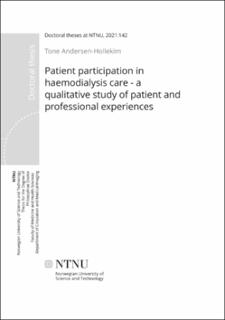| dc.description.abstract | Patient participation represents a shift in the health care system from the previous paternalistic models towards a more democratically oriented practice. This includes value based interaction models in which the patient and healthcare professionals share decisions regarding the patient’s health. In several countries, including Norway, patient participation is a statutory right, frequently cited, for example, in policy documents. Involving patients and their next of kin has several potential benefits and is particularly relevant for patients with long-term disease trajectories in frequent contact with health services, such as patients on hospital haemodialysis. These patients may be involved in various areas, for example, in treatment decisions and in determining the goals of treatment. Despite being promoted as an ideal for several decades, practical implementation of patient participation has been challenging. This doctoral thesis explores patient participation in different phases of the end-stage renal disease trajectory when patients require dialysis. The thesis comprises three articles that provide knowledge about patient participation based on the experiences of both patients and healthcare professionals. The patients were of working age and were treated with hospital haemodialysis. Their experiences included patient participation with regard to the choice of dialysis modality. The healthcare professionals included nephrologists and registered nurses working in dialysis wards. Our findings indicate different experiences with patient participation in the patient trajectory. Healthcare professionals recognised the choice of dialysis modality as difficult but emphasised that the modality decision should be made by the patient. By contrast, patients did not experience to have made this decision. Patients’ choice was influenced by healthcare professionals following recommended guidelines for dialysis treatment. Some professionals used shared decision-making to reach a modality decision, emphasising the patients’ lifestyle and preferences. The patients in the study experienced to receive good information. Within hospital haemodialysis, they felt safe and cared for, albeit limited regarding their scope of action. Both nephrologists and nurses emphasised the patient’s individual responsibility to adhere to the prescribed treatment and encouraged active participation. Inconsistent values between patients and professionals created tensions that necessitated negotiations. Healthcare professionals focused on evidence-based values. Patients’ priorities were 4 additionally related to life outside the dialysis ward. The patients experienced collaboration within and across the organisation as fragmented. This entailed individual responsibility for navigating the systems. For some patients, this led to a lack of trust in the healthcare system. Both nurses and nephrologists experienced that they worked within organisational frameworks in which efficiency requirements limited their opportunities to promote patient participation. | en_US |
